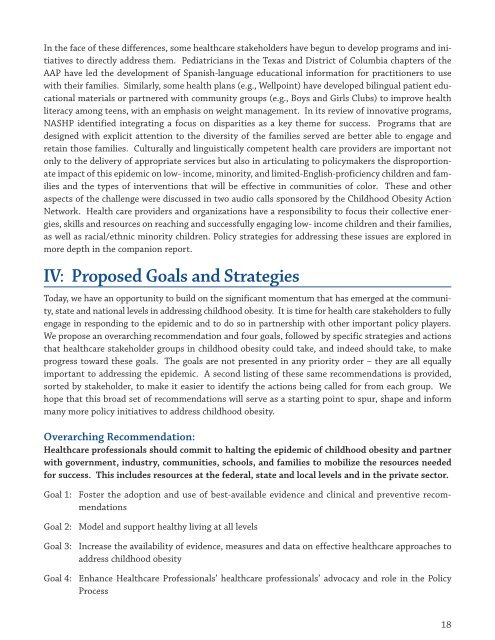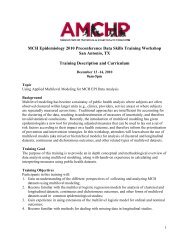Childhood Obesity: The Role of Health Policy - Association of ...
Childhood Obesity: The Role of Health Policy - Association of ...
Childhood Obesity: The Role of Health Policy - Association of ...
Create successful ePaper yourself
Turn your PDF publications into a flip-book with our unique Google optimized e-Paper software.
In the face <strong>of</strong> these differences, some healthcare stakeholders have begun to develop programs and initiatives<br />
to directly address them. Pediatricians in the Texas and District <strong>of</strong> Columbia chapters <strong>of</strong> the<br />
AAP have led the development <strong>of</strong> Spanish-language educational information for practitioners to use<br />
with their families. Similarly, some health plans (e.g., Wellpoint) have developed bilingual patient educational<br />
materials or partnered with community groups (e.g., Boys and Girls Clubs) to improve health<br />
literacy among teens, with an emphasis on weight management. In its review <strong>of</strong> innovative programs,<br />
NASHP identified integrating a focus on disparities as a key theme for success. Programs that are<br />
designed with explicit attention to the diversity <strong>of</strong> the families served are better able to engage and<br />
retain those families. Culturally and linguistically competent health care providers are important not<br />
only to the delivery <strong>of</strong> appropriate services but also in articulating to policymakers the disproportionate<br />
impact <strong>of</strong> this epidemic on low- income, minority, and limited-English-pr<strong>of</strong>iciency children and families<br />
and the types <strong>of</strong> interventions that will be effective in communities <strong>of</strong> color. <strong>The</strong>se and other<br />
aspects <strong>of</strong> the challenge were discussed in two audio calls sponsored by the <strong>Childhood</strong> <strong>Obesity</strong> Action<br />
Network. <strong>Health</strong> care providers and organizations have a responsibility to focus their collective energies,<br />
skills and resources on reaching and successfully engaging low- income children and their families,<br />
as well as racial/ethnic minority children. <strong>Policy</strong> strategies for addressing these issues are explored in<br />
more depth in the companion report.<br />
IV: Proposed Goals and Strategies<br />
Today, we have an opportunity to build on the significant momentum that has emerged at the community,<br />
state and national levels in addressing childhood obesity. It is time for health care stakeholders to fully<br />
engage in responding to the epidemic and to do so in partnership with other important policy players.<br />
We propose an overarching recommendation and four goals, followed by specific strategies and actions<br />
that healthcare stakeholder groups in childhood obesity could take, and indeed should take, to make<br />
progress toward these goals. <strong>The</strong> goals are not presented in any priority order – they are all equally<br />
important to addressing the epidemic. A second listing <strong>of</strong> these same recommendations is provided,<br />
sorted by stakeholder, to make it easier to identify the actions being called for from each group. We<br />
hope that this broad set <strong>of</strong> recommendations will serve as a starting point to spur, shape and inform<br />
many more policy initiatives to address childhood obesity.<br />
Overarching Recommendation:<br />
<strong>Health</strong>care pr<strong>of</strong>essionals should commit to halting the epidemic <strong>of</strong> childhood obesity and partner<br />
with government, industry, communities, schools, and families to mobilize the resources needed<br />
for success. This includes resources at the federal, state and local levels and in the private sector.<br />
Goal 1: Foster the adoption and use <strong>of</strong> best-available evidence and clinical and preventive recommendations<br />
Goal 2: Model and support healthy living at all levels<br />
Goal 3: Increase the availability <strong>of</strong> evidence, measures and data on effective healthcare approaches to<br />
address childhood obesity<br />
Goal 4: Enhance <strong>Health</strong>care Pr<strong>of</strong>essionals’ healthcare pr<strong>of</strong>essionals’ advocacy and role in the <strong>Policy</strong><br />
Process<br />
18



